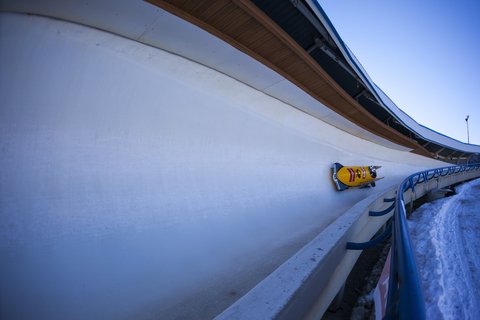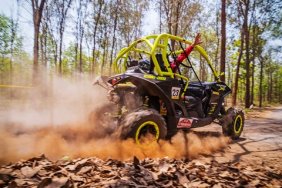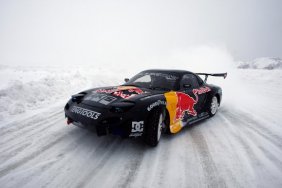Have you ever thought of bobsledding? While the sport sounds exotic, you can get started at one of four sanctioned tracks in North America.
There are only 15 tracks sanctioned for competition by bobsledding’s International Federation with one of the newest in Whistler, British Columbia.
Despite originating on the icy slopes in Switzerland, bobsledding is strongly associated with the country of Jamica, thanks in large part to the movie Cool Runnings.
And the just-released biographical movie Eddie the Eagle chronicling the sports journey of a British ski jumper’s life struggle and eventual Olympic appearance has sparked a renewed interest in the sport.
The big surprise is that these and other slippery ice sports are within reach for daring adventurers who want to take a test ride – or fly – and experience the thrills for themselves.
Bobsledding
Bobsledding is a thrill ride for two or four, rocketing down an icy track in a bullet-shaped sled while attempting to record the fastest time. It’s a bit like a roller coaster and notoriously dangerous.
The crew makes a sprint start before hopping aboard for the wild descent. Safety gear including helmets and protective suits are a must, and both the pilot and pushers are important to this sport that requires a smooth, fast start. Passengers crouch into an aerodynamic position as the sled speeds through a series of curves and straightaways.
The Whistler Sliding Center runs daily public bobsled sessions where complete beginners are taken through an orientation, learn track etiquette, and see a mock run before meeting their pilot and crew and hurling down the 1700m track at speeds that can exceed 80 mph.
It’s a difficult sport to practice unless you belong to a club or a team, but if you’re serious it’s worth riding on the world’s only refrigerated bobsled run located where the sport was born, in St. Moritz, Switzerland. The track stays open until March and you can advance book guest rides.
Skeleton
Skeleton is the crazy cousin of bobsledding, a head-first ride on a sled about the size of a large serving tray. Simple, right? Lay down, eyes forward, arms in and feet up, and enjoy the ride. Instructions on send-off are simple, too…don’t move!
Basically it involves going face-first down an ice track on a sled with no steering device. Athletes have to control the sled using spikes on the tips of their shoes, dragging them in the ice as they speed down the course.
If the thought of hitting speeds of 85 mph inches from the ice unnerves you, add in the fact that you can also experience up to a 5G force – way more than the average roller coaster.
You can go for an intro session at Utah’s Olympic Park in what is called the “G Force Fantasy Camp.” The 1335m track there has five alternate starts to accommodate beginners so they’re not immediately thrown into the deep – and icy – end. Camp includes up to three runs, a track walk with Olympic coaches, and some tips from those experts who train you in basic skeleton driving skills.
If you fall in love with this fast, slick sport the problem is where to train. If you’re looking for the real deal, Cortina d’Ampezzo in Italy, site of the 1956 Olympics, has both a vibrant club and a fast track set against the backdrop of the Dolomites.
Ski Jumping
Ski jumping is a sport best known for its underdogs. In the UK’s case, that was “Eddie the Eagle” Edwards, their first ever Olympic jumper who was sadly the worst in the world. But Eddie had fun, and did attain some celebrity. Now his story is the basis for a movie.
Ski jumping is both simple and scary. You speed down a huge hill and at the end of the ramp it becomes a contest to see who can fly the farthest off the end and land upright. The sport has been part of the Winter Olympics since 1924 and in recent years women have been allowed to compete.
This is not a sport you can try on a ski holiday and in most cases you need to belong to a club to get started. Oslo, Norway’s Holmenkollen jump was completed in 2010 using 100 tons of steel and is one of the world’s most significant jumps – complete with a ski simulator that gives hopefuls a pretty good idea of what they’re in for.
In Steamboat Springs, Colorado, a good number of ski jumpers train for the Olympics at Howelson ski area, home to the largest and most complete natural ski jumping complex in North America. Jumps range from 20m to 75m, and even kids can get a taste for flying on the miniature “Bump Jump.”
© Imagecom | Dreamstime.com – Bobsleigh World Cup Calgary Canada 2014








